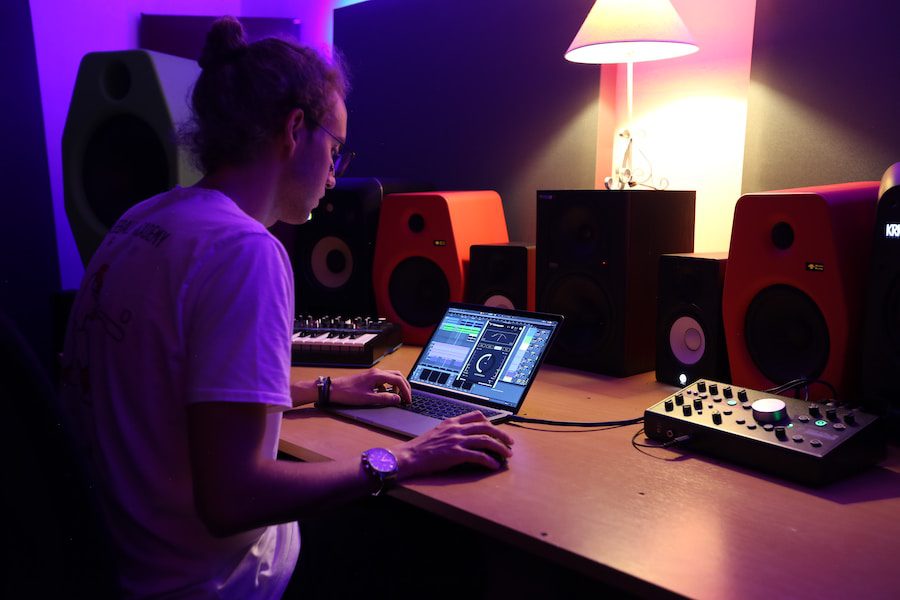Choosing the right room to record in is crucial for anyone looking to produce high-quality audio recordings, be it for music, voice acting, or podcasts. The recording space’s characteristics can significantly impact the final product, making selecting a room that best suits the project’s needs essential.
Several factors contribute to determining the most appropriate room for recording, such as room size, shape, and acoustic properties. These aspects can affect sound quality by influencing reverberation, echo, and the recording’s frequency response. To achieve the best results, it is essential to consider these details and make necessary adjustments to minimize unwanted noise and maximize audio fidelity.
Assessing potential recording spaces for their acoustic qualities is an essential practice for amateurs and professionals. By doing so, they can take advantage of the optimal room setup and create recordings that accurately reflect their desired sound, ultimately leading to a more enjoyable listening experience for their audience.
Table of Contents
- Understanding Acoustic Properties of Rooms
- The Home Studio
- Professional Recording Environment
- Hybrid Solutions for Recording
- Summarizing What Room to Record In

Understanding Acoustic Properties of Rooms
When selecting a room for recording, it’s essential to consider the acoustic properties of the space. This includes the room’s size and shape, the types of surfaces and materials, and ways to reduce echo and reverb. This section will provide an overview of these important factors.
Room Size and Shape
Rooms with different dimensions will have specific frequency responses, which means certain frequencies may be emphasized or diminished.
Larger rooms tend to have a more balanced sound, while smaller rooms can cause certain frequencies to build up due to wall reflections.
Avoid perfectly square or rectangular rooms, as they can generate standing waves that result in an uneven frequency distribution. To minimize this issue, look for rooms with irregular shapes or asymmetrical elements.
Types of Surfaces and Materials
The surfaces and materials in a room will greatly affect its acoustic properties. Hard and reflective surfaces, such as tile, glass, and concrete, will increase reverberation, while softer, more absorptive materials, like carpet and curtains, will help dampen sound. The table below displays different types of surfaces and their impact on acoustics.
| Surface Type | Acoustic Properties |
|---|---|
| Hard flooring (e.g., tile) | Reflective, increased reverb |
| Soft flooring (e.g., carpet) | Absorptive, reduced reverb |
| Windows (glass) | Reflective, increased reverb |
| Curtains or drapes | Absorptive, reduced reverb |
For a balanced sound, it’s important to balance reflective and absorptive surfaces within the recording space.
Reducing Echo and Reverb
Echo and reverb can negatively impact the clarity of a recording. To minimize unwanted echoes and reverberation, consider using some of the following techniques:
- Add absorptive materials to the room, such as carpets, blankets, curtains, or foam panels.
- Position microphones closer to the sound source to reduce the amount of reflected sound picked up.
- Use directional microphones to focus on the sound source and minimize room reflections.
- Experiment with different microphone placements and angles to find the optimal sound quality.
Ensuring a room has the right balance of acoustic properties is crucial for achieving high-quality recordings. By considering room size and shape, types of surfaces and materials, and methods for reducing echo and reverb, the recording space can be optimized for any recording application.
The Home Studio
Creating a home studio is an exciting process, but it can also be a challenging task. Choosing the right room, maximizing the available space, and soundproofing on a budget are all essential aspects to consider.
Choosing the Best Room in Your Home
Consider a few important factors when looking for the perfect room to set up your home studio. Firstly, the size of the room plays a crucial role in the overall sound quality.
Opt for a medium-sized room with enough recording equipment and desk space. Avoid corners or square rooms, as they can create unwanted sound reflections. Secondly, consider a room with limited outside noise and minimal foot traffic. This helps maintain a quiet recording environment.
Maximizing Your Recording Space
Once you’ve chosen the best room, it’s time to maximize your recording space. To achieve this, consider the following tips:
- Invest in space-saving equipment such as foldable microphone stands, wall-mounted speakers, or a desk with built-in storage.
- Arrange your gear ergonomically to access all necessary equipment during recording sessions easily.
- Leave some space for sound absorption panels or acoustic foam to improve the acoustics.
Budget-friendly Soundproofing Techniques
Soundproofing a home studio can be expensive, but there are affordable options. Some budget-friendly soundproofing techniques are:
- Seal gaps and cracks in the windows, walls, and doors with weatherstripping or draft stoppers to minimize outside noise.
- Add rugs, curtains, or furniture to the room to absorb sound and reduce reflections.
- Use DIY sound absorption panels from affordable materials like Rockwool or rigid fiberglass boards wrapped in fabric.
You can create a functional and efficient home studio by choosing the right room, maximizing your recording space, and utilizing budget-friendly soundproofing techniques.
Professional Recording Environment
A professional recording environment is essential for achieving high-quality audio recordings. This section dives into creating such an environment, discussing purpose-built studios, treating live rooms and control rooms, and investing in high-quality soundproofing.
Purpose-built Studios
Purpose-built studios are specifically designed and constructed for audio recording and production. These studios offer several benefits, including:
- Optimized acoustics to ensure accurate sound reproduction
- Soundproofing to isolate external noise and prevent sound leakage
- Ergonomic and functional layout for efficient and comfortable workflow
Choosing the right location and building materials can significantly affect a purpose-built studio’s sound quality and recording experience.
Treating Live Rooms vs. Control Rooms
When setting up a professional recording environment, it’s essential to understand the different treatments required for live rooms and control rooms. Live rooms are where the musicians perform, whereas control rooms are where the recording engineer and producer manage the recording process.
| Room | Treatment Goal |
|---|---|
| Live Room | Control and shape the reflections, reverberations, and overall acoustic character of the space, ensuring that the recorded sound remains clear and natural. |
| Control Room | Eliminate early reflections, flutter echo, and excessive reverberation, providing a neutral and accurate monitoring environment for critical listening and decision-making during the recording process. |
Effective treatment of both live and control rooms is crucial for achieving professional results in the recording process.
Investing in High-Quality Soundproofing
Soundproofing is an essential aspect of any professional recording environment. This prevents unwanted external noise from entering the recording space and reduces sound leakage, promoting accurate sound capture and minimal disturbance to the surrounding areas.
Some key considerations for soundproofing include:
- High-quality insulation materials absorb sound energy and reduce transmission
- Resilient channel systems and decoupled wall construction to minimize structural vibrations and sound transmission
- Airtight doors and windows to prevent leakage of air and sound
Proper soundproofing ensures a quieter, more controlled recording environment, leading to better sound quality and a more professional end product.
Hybrid Solutions for Recording
Various hybrid solutions for recording address the challenges of finding the perfect recording room. These solutions allow for flexibility and improved sound quality when recording in less-than-ideal spaces. The following sub-sections discuss portable recording booths, isolation shields and reflexion filters, and utilizing virtual acoustics.
Portable Recording Booths
Portable recording booths provide a temporary and transportable recording environment mimicking a full-sized booth. They can be set up in any room and easily assemble and disassemble. These booths often feature:
- Acoustic foam or other sound-absorbing materials
- Ventilation systems to ensure air circulation
- Ample space for a microphone and other necessary equipment
Portable booths offer sound isolation and controlled acoustics that can greatly improve the quality of recordings in sub-optimal spaces.
Isolation Shields and Reflexion Filters
Isolation shields and reflexion filters are other solutions for creating better-sounding recordings without a dedicated space. These devices attach to the microphone stand and block and absorb unwanted noises and reflections in the room. Some benefits include:
- Reduced room noise and reflection
- Improved vocal clarity and focus
- Portable and easy to set up
Isolation shields and reflexion filters help to achieve a cleaner sound in rooms with poor acoustics, though they are not a substitute for a properly treated recording space.
Utilizing Virtual Acoustics
Virtual acoustics can simulate the characteristics of a professionally treated recording environment. With digital signal processing (DSP) software and algorithms, a recording made in a sub-optimal space can be processed to emulate the sound of a high-quality room closely. Virtual acoustics may involve:
- Impulse response analysis
- Convolution reverb processing
- Room emulation plugins
Although virtual acoustics can provide a convincing approximation, they may not always perfectly replicate the ideal recording environment. It is worth considering these technologies in combination with other hybrid solutions for the best results.
Summarizing What Room to Record In
Choosing the right room for recording plays a vital role in achieving professional-sounding audio. Room size, shape, and materials significantly impact sound quality. In general, it is crucial to pay attention to:
- Room dimensions to reduce standing waves
- Absorption materials to dampen reflections
- Diffusion to scatter sound waves
Small rooms with irregular shapes are typically easier to treat acoustically, while larger rooms may require more advanced solutions. When selecting a recording space, one should consider sound isolation and minimizing outside noise.
Additionally, it is essential to experiment with microphone placement and utilize various techniques to shape the desired sound. One can achieve a professional recording environment by considering these factors and investing time in a room’s acoustic treatment.
- Review of the ALABS IRON MINI-WL: A Powerhouse Wireless Microphone - October 4, 2023
- What is a Saturator in Music Production: A Brief Explanation - May 11, 2023
- What Are Rotary DJ Mixers? An Overview - May 11, 2023
SoundStudiomagic.com is a participant in the Amazon Services LLC Associates Program, an affiliate advertising program designed to provide a means for sites to earn advertising fees by advertising and linking to Amazon.com. We also participate in other affiliate programs which compensate us for referring traffic.

